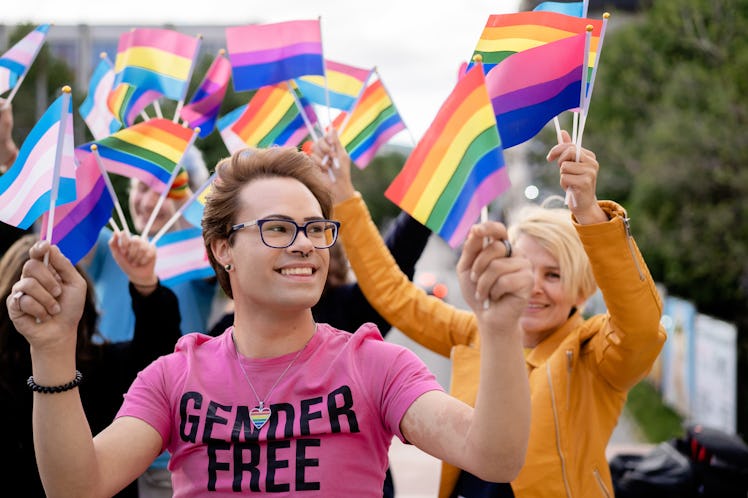The Life-Saving Reason Trans Teens Need Access To Gender-Affirming Hormone Therapy
Decades of scientific research show that hormone therapy can be absolutely necessary for gender diverse adolescents.

Despite what anti-trans bills circulating around the U.S. would have you believe, the science is clear: Gender-affirming hormone therapy is vital to the health and well-being of transgender youth.
Doctors have used hormones to alleviate gender dysphoria — the distress of living in a body that conflicts with someone’s gender identity — for nearly a century. Several high-profile studies over the past few decades have confirmed their safety and necessity in teenagers, as well.
Trans adolescents who receive gender-affirming hormone therapy report less depression and less suicidal ideation compared to their peers who don’t receive such therapy. This is extremely important because this population has a significantly elevated risk of suicidality. A 2019 study found, for example, that more than half of transgender minors have attempted suicide.
Like many gender-affirming medical treatments, hormone therapy is not easily procured, nor is it offered to any willing teen on the street. Most medical institutions in the United States follow gold standard guidelines from the World Professional Association for Transgender Health and the Endocrine Society, which differ slightly but suggest that teens can start this therapy at ages 14 and 16, respectively. It’s uncommon for hormones like estrogen and testosterone to be given to younger transgender and gender diverse (TGD) adolescents, who are typically started on puberty blockers to avoid or halt the distressing physiological changes that often accompany puberty for them.
Gender-affirming health care in general for youth is not controversial in any of the major establishment medical societies.
The very clear scientific consensus has not made it easy for many individuals to access gender-affirming care, however. Wait times for initial intake appointments routinely stretch into years, and waves of anti-trans legislation have further limited or even banned individuals from receiving this necessary care in certain states. These policies mean that kids who need access to these therapies either don’t get them, must travel very far for life-saving medical care, or have to move out of the state.
The recent political backlash disrupted this relative normalcy and has been bizarre to watch, says endocrinologist Joshua Safer, who runs the Mount Sinai Center for Transgender Medicine and Surgery in New York. “Gender-affirming health care in general for youth is not controversial in any of the major establishment medical societies,” Safer said in an email. “I am baffled that there are so many politicians willing to demonize vulnerable youth for what seems to be political gain.”
Making children feel ashamed for being honest and making children feel ashamed for being authentic — I'm just not sure how anybody could feel like that is a good idea.
The focused political attacks on trans youth becomes even more absurd when considering how few trans kids there actually are. A Reuters analysis found that 14,726 minors with a gender dysphoria diagnosis started hormone treatment from 2017 through 2021 in the U.S. Out of the country’s 74 million minors, that’s just .0001% of that population.
“Making children feel ashamed for being honest and making children feel ashamed for being authentic — I'm just not sure how anybody could feel like that is a good idea. There is no study that says that this [benefits] any child,” says Michelle Forcier, M.D., a professor of pediatrics at Brown University who has provided gender-affirming care for hundreds of adolescents throughout her career.
Although the timeline, specifics, and goals of hormone therapy vary for every TGD individual, it generally leads to physiological changes like the development of secondary sex characteristics that can alleviate gender dysphoria. For transmasculine people taking testosterone, this can manifest as increased facial hair, a deeper voice, and a changed facial shape. For transfeminine taking estrogen, it can manifest in breast development and pelvis widening.
The medical world is not pushing kids to gender diversity. Gender diverse kids are coming to the medical world saying, ‘Can you help me?’
Some opponents of gender-affirming care say the topic needs more data due to a dearth of randomized control trials, which are typically the gold standard for scientific research. But conducting this kind of research — which would require withholding critical therapies from a control group of TGD kids — when it is clear that doing so would harm the participants, is ethically and morally bunk, says Forcier.
“If you're diabetic, no one would put you in a clinical trial and say, ‘Well, let's see what happens if you don't get any diabetes medicine.’ That would just be so wrong,” she says.
Other critics suggest the side effects from hormone treatment are substantial, but there is scant evidence supporting this claim. Transfeminine individuals may see an elevated risk of strokes and blood clots compared to cisgender males and females, but overall the risks of gender-affirming hormone therapy are relatively minimal.
The gains, however, are substantial: increased quality of life, decreased depression and anxiety, and a marked decreased risk of suicidality. The data matches the behavior of TGD adolescents, who rarely discontinue hormone therapy. A 2022 study found that 98% of 720 participants at a gender identity clinic in Amsterdam continued the therapy into adulthood, suggesting that these individuals found the treatments helpful. A 2023 study found that among 82 TGD adolescents treated at an academic pediatric endocrinology center in Atlanta, only three halted their hormone therapy, and none of them resumed identifying as their sex assigned at birth.
Forcier says these studies help demonstrate how crucial gender-affirming care is for transgender and gender-diverse kids — and how much the kids want and need the treatments.
“The medical world is not pushing kids to gender diversity. Gender diverse kids are coming to the medical world saying, ‘Can you help me?’” she says. And the evidence shows that with gender-affirming hormone therapy, it can.
This article was originally published on